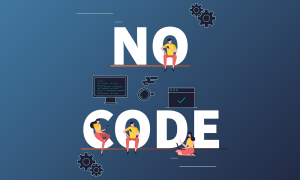One of the most typical issues firms confront, is whether to purchase commercial off-the-shelf (COTS) or construct custom solutions.
If buying was the apparent choice in the past, the increasing drive for better customer experience and operational efficiency has prompted many firms to prefer software that fully adapts to their organization’s quirks.
Of course, not everything needs to be totally personalized, so despite the trend away from off-the-shelf software, it continues to play an important role in many firms’ digital strategies. In reality, prominent digital organizations are combining buying (or renting) software with producing it as part of a new set of rules for procuring, renewing, and operating digital assets.
While the conflict between low-code platforms and customized softwares might not have the heritage of Coke vs. Pepsi, Apple vs. Samsung, or Star Trek vs. Star Wars, it’s definitely a comparison worth examining for organisations deciding to construct their own custom software solution.
Many teams and employees are fed up with the inconveniences of COTS software.
We’ve got a second option in place for 2021 and beyond.
Defining COTS software and its limitations
COTS (commercial-off-the-shelf) software refers to software applications and products that are ready-made and sold in the commercial market.

It’s like “one-size-fits-all” software because it’s pre-made, and it can’t possibly match every possible customer’s demands completely unless customised, yet most COTS software has limited modification choices.
Sure, a few COTS providers may offer customization beyond what is offered in the product as a paid service, but it will come at a high price. Businesses also pay a significant cost since customisation is required because the software does not always fit the customer’s demands as-is.
IT is constantly overburdened as more individuals work from home, and software developers are in short supply. COTS software is also a dangerous option in the face of widespread digital disruption because enterprises can’t afford to limit their operational capabilities because of what COTS software provides.
Furthermore, COTS customisation necessitates time, which no organisation can afford to lose.
What is No-Code?
No-code is an ideal solution for many business owners. It’s a recent innovation, as development began around the same time as lowcode.
Users can create apps and use specific software without any coding knowledge.

Users need to apply some form of coding logic, but no-code development simplifies the logic and process of making these developments accessible to everyone.
You can use No Code to create many apps like Low Code. Most platforms optimize no-code for business use. Instead of paying professional developers to create apps, companies can get inexperienced coders to develop apps in less time than normally needed.
Users don’t need any prior coding experience to create apps using no-code.
You can quickly construct applications in minutes or hours to automate and manage all your tedious activities.
Therefore, companies facing difficulties in automation and streamlining IT procedures can consider utilizing no-code software.
No-code development platforms (NCDPs) are becoming the preferred tool for app development, and companies often choose no-code over COTS.
NCDP may have some limitations, but providers are increasing their no-code use cases every day. A no-code development platform is an overwhelmingly easy-to-use solution. But is no-code better than COTS?
No-code vs COTS software: Comparison
- Clutter in the IT Department
One COTS for each business case, such as CRM, Help Desk, Accounting Software, Expense Management, and so on, can lead to software clutter, resulting in data redundancy and maintenance concerns.

When used for general-purpose automation, a no-code software platform can be used to automate processes and construct applications for all departments in the firm on a single platform, removing the risk of software clutter and data redundancy.
- Skills
Customization options for COTS products are restricted.
Any customization that goes beyond what the product offers must be done by the vendor himself.

Business users and the central IT team are powerless to help. Professional developers are required for such efforts, even if IT is authorized to customize the COTS product.
Building software with no code, on the other hand, takes no skills or even basic programming experience. Apps can be developed and customized by anyone from any department or by the user.
No-code app creation also makes it easier to make changes and upgrades.
For customization beyond what is provided in the product, COTS apps necessitate the intervention of programmers.
- Time
In most cases, COTS software is set up and deployed in a matter of minutes.

No-code apps can be produced and deployed in a matter of minutes to days, depending on what is being built.
Many no-code software platforms offer ready-to-use building pieces for fast developing and deploying software. Delays and debugging are also no longer a source of concern.
- Cost
Costs are very high since COTS software development involves weeks or months of development effort from qualified professional developers.

They can be purchased for a set price plus an annual maintenance fee, or they can be purchased as a SaaS subscription that is paid monthly or annually.
No-code platforms, on the other hand, are far less expensive than COTS software.
These are often given as a SaaS subscription that is paid on a monthly or annual basis and may be used to solve different business challenges and build multiple solutions with the same subscription.
- Agility
One of the most significant drawbacks of COTS software is its lack of agility.
There are only a few customising options available. Any customization beyond what is included in the product is either impossible or requires the vendor’s involvement.

This might lead to a negative customer experience and frustration.
No-code apps are extremely adaptable, allowing for quick modifications without disrupting the user experience.
In fact, they make it better by allowing users to add features based on their needs and feedback.
- Complexity
There is commercial off-the-shelf (COTS) software available to solve complicated business challenges.
However, the few customising possibilities they offer continue to be a major drawback.
In this situation, though, No-code has been filled with myths.
Many users assume that no-code development is only appropriate for simple applications. The truth is that there are a variety of advanced no-code platforms available that allow you to create everything from simple to complex enterprise-grade apps. COTS, on the other hand, may have limited capabilities in this area. As a result, you must be cautious during your evaluation.
- Integration
Integration options are available in most common COTS software, but they may be limited.

Integration is possible with no-code platforms thanks to APIs and ready-to-use plugins and adapters.
However, as a customer, you must first verify the integration capability before making a decision.
- Innovation
No-code software platforms give customers the tools they need to create and invent new.

solutions to their problems. They also free up time and provide you the freedom to think and act at the same time.
COTS software, on the other hand, does not allow for much innovation because it cannot be changed by the end users.
- Reusability
No-code development also has the benefit of reusability in the workplace and pre-configured modules and functionality for apps.

These modules typically contain all the basic and core functionality required by various programmes, and they may be quickly and readily utilized for multiple alternative solutions.
When using COTS software, this is usually not possible.
Conclusion
Both custom software and no-code solutions offer their own set of benefits.
The advantages of each are mostly determined by the needs of the firm that will be employing the software, as well as the organization’s infrastructure. It may be worthwhile for a company with 500 users in a niche with complicated, highly customized software needs to custom-make their own software.
Whereas, a company that requires customized but common business applications (CRM, expense management, inventory monitoring, and so on) may choose the low-tech, DIY aspect of no-code platforms.


IT
5 Big Challenges facing CIOs and IT leaders in Pandemic 2021

LCNC
The Ultimate Guide on How to Find a Low code/No code Platform for your Business

LCNC
5 Important Metrics to Measure the ROI of Low-Code

LCNC
8 Essential Factors of Low-code/No code Software


LCNC
The Best No-code Apps for Website Development

IT
Task Management App Vs. Work Execution Platform: What Do You Need and What’s the Difference?

IT
Digital Transformation: 7 Important Questions for Your Organization

LCNC
7 Reasons Why Low code is the Ideal Solution for Business

IT
Top 10 Types of Software Every Business Needs-Infographic

General
The Best Airtable Alternatives to Look Out for in 2021 and Beyond



